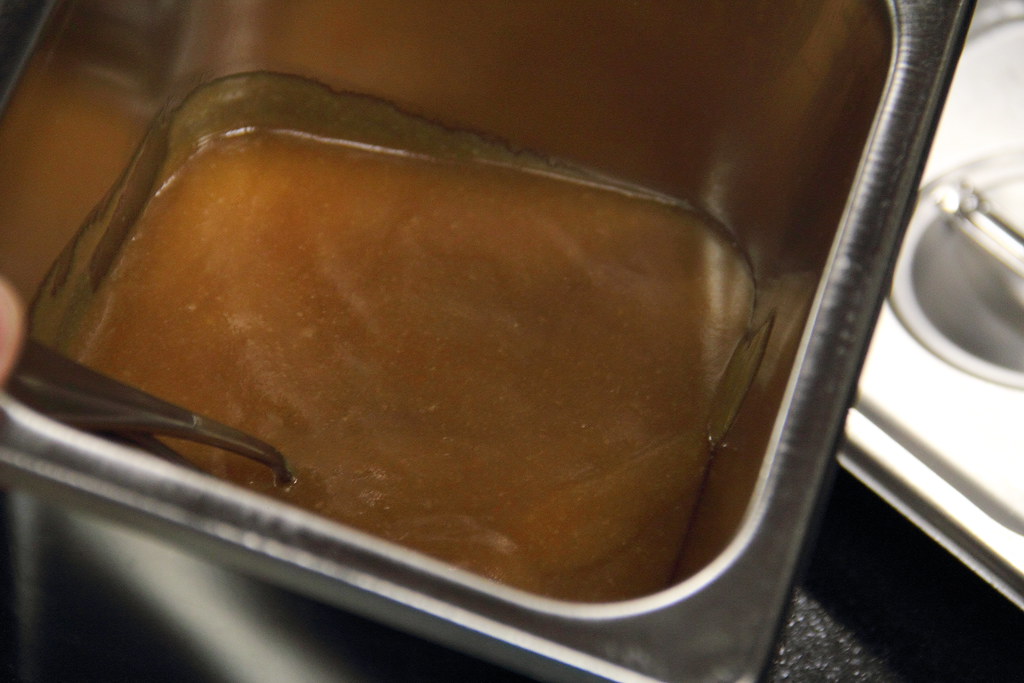Sunday, March 30, 2014
Ramen Making @ The Eureka Cooking Lab
On a Saturday afternoon, a group of us (Martin, Tony, Ian, Philip, Nicole and me) gathered at The Eureka Cooking Lab (TECL) to learn about the art and science of ramen making from Chef Jason Lim. Chef Jason Lim is also the CEO and co-founder of TECL conducts a 2-3 days Japanese Ramen Classfor Professional for those that is interested in setting up their own ramen business. The 3 days class even includes business consultancy too. Chef Jason Lim has specially compacted the class into a 2 hours session to briefly walk us through some of the key component of making a bowl of ramen.
As you can see from the pictures, The Eureka Cooking Lab is very modern designed, spacious and has a well equipped kitchen.
The first thing we learn is to make the ramen noodle. This is the machine that will produce our final product.
The ramen noodle is made from a mixture of gluten powder, egg white powder, kansui and distilled water. Chef Jason even gave us a brief lesson in science, how the molecular structure of distilled water allows the broth and noodle to absorb the essence faster and more. There is also advantage of cooking ramen noodles in distilled water as the molecules of starch and salt exchange with that of the water, allowing noodles to cook faster and hence retaining the texture.
The mixture is made into dough sheets.
Then it is cut into the size and texture of the noodles you want.
Egg white powder or whole egg powder is added to the mixture to produce the ramen noodles. Subject to the broth that you are using, the general rule of thumb is to use egg white powder for thick broth and whole egg powder for light broth. Simply because noodles made from egg white powder is not as absorbent compared to whole egg powder. Hence the egg white powder made noodle will not absorb the thick broth and make the whole ramen experience overpowering. On the other hand, the whole egg powder noodle is more flavourful and absorb better will help to complement the light broth.
Moving on we proceed to the kitchen to learn about the broth making. Using a combination of pig trotter, thigh bone and chicken carcass to make the tonkatsu broth. It would be better to use backbone as it breakdowns faster but comes at a higher cost. Hence commercial kitchen usually will use the front part of trotter instead. The used of chicken is to mask the porky flavour.
The tonkatsu broth was only the base of the soup. The next step is to flavour the soup. Depends on the characteristic in each bowl of ramen, one may choose to add a blend of sea salt and seafood, soy sauce and seafood, miso etc. That gives the flavour of the soup that is formed into a paste.
All together there is 3 stages of the broth. The last stage is the oil. This gives the broth the aroma which can be either a single blend or a mix of them such as dried shrimp oil, garlic oil, shallot oil.
The above 3 components, soup, paste and oil are mixed together before servicing a bowl of hot piping ramen.
The beautiful pork belly is cooked at 80 degree celsius and them simmer in a braising sauce. Chilled, sliced and given a blown torch to it before servicing.
Last but not least it is cooking the ramen and putting all the ingredients together. Of course we cannot forget the tamago egg. A trick that Chef Jason Lim taught us is to use a thumbtack and poke the egg. This will let the air in while cooking the egg for about 5 minutes in boiling water and then transfer to ice water.
Finally after 2 hours, this is our bowl of piping hot ramen. I have learnt a lot from the ramen making session and gain very valuable knowledge. It makes me appreciate my bowl of ramen even more now, knowing all the hard work behind a bowl of slurping good ramen.
Like I mentioned earlier, this ramen making session was specially arranged and compact into 2 hours to just show us what one gets to learn in the 2-3 days Japanese Ramen Class for Professional conducted by Chef Jason Lim. Chef Jason has gone all the way to Japan to learn the art and he is now teaching this to those who wants to start a ramen business. Coupled by his experience in the local F&B scene when he used to run a ramen restaurant, he has incorporated business consultancy in the course to advice and assist owners to be in setting up the whole business. Besides the Japanese Ramen Class, The Eureka Cooking Lab is also available for corporate events, private events, team building events and many other classes. For more info, you can check out the facebook or website.
The Eureka Cooking Lab
8 Jalan Kuras
Singapore 577725
Tel: +65 64564322
Facebook: https://www.facebook.com/TheEurekaCookingLab
Website: http://www.tecl.sg
Nearest MRT: Marymount (CC Line)
Opening Hours:
Mon-Sat: 9am - 6pm
Direction:
1) Alight at Marymount MRT station. Take Exit A. Walk to Upper Thomson Road towards SPC Petrol Kiosk direction. Take bus number 163, 167, 855 or 980 across the road (Stop ID B53021). Alight 7 stops later. Walk to destination across the road. Journey time about 20 minutes. [Map]
Labels:
.Station: Marymount,
#Line: CC Line,
Char Siew,
Egg,
Noodle,
Ramen,
Soup
Subscribe to:
Post Comments (Atom)


No comments:
Post a Comment